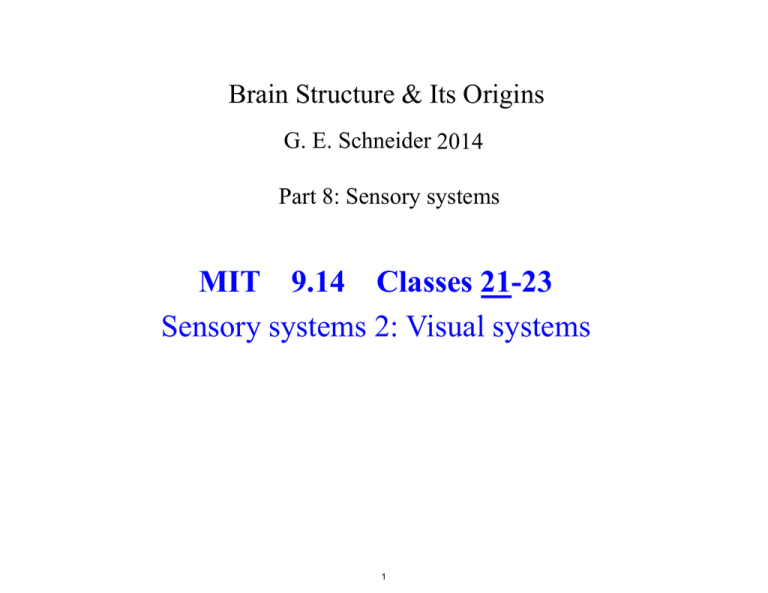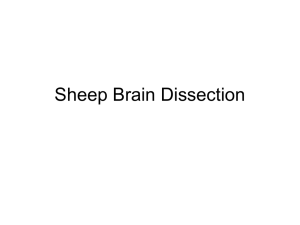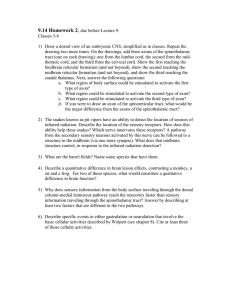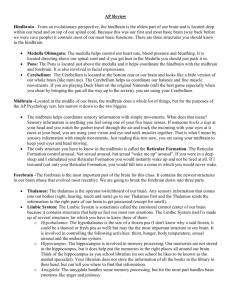MIT 9.14 Classes 21-23 Sensory systems 2: Visual systems
advertisement

Brain Structure & Its Origins G. E. Schneider 2014 Part 8: Sensory systems MIT 9.14 Classes 21-23 Sensory systems 2: Visual systems 1 9.14 Where we are now in the outline Courtesy of MIT Press. Used with permission. Schneider, G. E. Brain Structure and its Origins: In the Development and in Evolution of Behavior and the Mind. MIT Press, 2014. ISBN: 9780262026734. 2 Part 1: Introduction Part 2: Steps to the central nervous system Part 3: Specializations in the evolving CNS – With an introduction to connection patterns Part 4: Development and differentiation – Spinal cord development and organization – Autonomic nervous system development and organization Part 5: Differentiation of the brain vesicles. • • • • Hindbrain development, elaboration and specializations Midbrain and its specializations Forebrain of mammals with comparative studies relevant to its evolution Differentiation during development: The growth of the long extensions of neurons Part 6: A brief look at motor systems Part 7: Brain states Part 8: Sensory Systems • Gustatory and olfactory systems * • Visual systems 3 Topics for class 21 • Origins of vision, 1: Light detection • Origins of vision, 2: Image formation CNS structures serving three major functions: 1) predator escape, 2) orienting towards objects, 3) identifying patterns and objects (leading to approach-avoidance decisions) • Retinal projections in vertebrates, with introductions to specializations 4 Questions, chapter 16 1) What was in all likelihood the first functional role of the visual sense? Describe the nature of the most primitive projection of the eyes to the brain. (Although it was probably the first retinal projection, it was the last major retinal projection in mammals to be found by modern neuroanatomists.) 5 Origins of vision, 1: Light detection • Why was it so important to detect light? This function long preceded image formation and topographic projections. 6 Origins of vision, 1: light detection • Primitive origins: Light sensitivity in protozoa and metazoa • Phylum Chordata: Amphioxus brain – Rudimentary light detectors of the diencephalon: located dorsally and ventrally (see Allman figures, pp 69, 70). – The pigmented area may produce some directionality in the light-detection responses since it can produce a shadow. • An important function that made light sensitivity adaptive: Organizing the day and night for efficiency and for safety 7 From Class 3 Amphioxus frontal eye spot may correspond to the developing eye in vertebrates: t Epithelium men g i P Pig m t Cells en Retina Optic nerve Nerves R e c e p tor a n d n e r v ec s ell Amphioxus Frontal Eye Spot Developing Vertebrate Eye ,PDJHE\0,72SHQ&RXUVH:DUH 8 From Class 3 Amphioxus brain, and the brain of a primitive vertebrate Amphioxus Frontal Eye Spot Pigment Photoreceptors Primitive Vertebrate Telencephalon Olfactory Bulb Retina Lamellar Body: mediates photoperiodic behavior Neurosecretory Cells: Control basic physiological functions, reproduction Parietal Eye: mediates photoperiodic behavior Optic Tectum Hypothalamus and pituitary ,PDJHE\0,72SHQ&RXUVH:DUH 9 Other recent work on Amphioxus has concerned gene expression data (Holland et al.). A proposal that Amphioxus has no endbrain has been made, but has not been fully supported. Some studies have suggested that both olfactory and hypophyseal placodes can be found during development. Organizing the day and night for efficiency and for safety – It was important to have this organization even when external light levels are very variable from day to day. – It was also important to synchronize the daily rhythm with the solar day-night cycle. – The advantages of this function led to the evolution of light detection with a connection to a biological clock. – Such a clock is located, in vertebrates, at the base of the caudal forebrain (in the hypothalamus). • Also important: Effects of varying levels of light on the level of activity • Control of these functions in vertebrates: Hypothalamus & epithalamus 10 Questions, chapter 16 2) Light controls the daily rhythm of secretion of melatonin by the pineal gland. How is this control accomplished? Describe two different pathways in different animals, one much more ancient in evolution than the other. 11 Illustrations • Mammalian suprachiasmatic nucleus • Pineal gland and melatonin production 12 Figure removed due to copyright restrictions. Please see course textbook or: Ling, Changying, Gerald E. Schneider, et al. "Target-specific Morphology of Retinal Axon Arbors in the Adult Hamster." Visual Neuroscience 15, no. 3 (1998): 559-79. 13 A. Suprachiasmatic nucleus (SCN) in the rat, Nissl stained coronal section of hypothal-amus at the level of the optic chiasm (OC). B. Terminations of retinohypothalamic tract (darkly stained). [Less sensitive method] Figure removed due to copyright restrictions. C. Vasoactive intestinal peptide-containing neurons in ventro-lateral SCN. D. Vasopressin-containing neurons in dorsomedial SCN. R. Moore, in Zigmond et al., 1999 14 Pathway for controlling the daily rhythm of melatonin production Pineal gland PVH Lat Horn, T1-2 Optic Nerve Retina SCN SCG Courtesy of MIT Press. Used with permission. Schneider, G. E. Brain Structure and its Origins: In the Development and in Evolution of Behavior and the Mind. MIT Press, 2014. ISBN: 9780262026734. 15 Origins of vision, 2: Image formation a) The most important functions of image formation with location-specificity in retinal projections*: • Predator avoidance and escape • Use of novelty detection for advanced warning b) Next in importance: Orienting towards novel objects for exploration, finding food or finding potential mates or rivals c) Finally, identifying animals and objects * Important for survival (to pass on genes) 16 Questions, chapter 16 3) Recall the hypothesis using Darwinian logic concerning the evolution of a predominantly crossed representation of visual space. 17 2a) Predator avoidance and escape: Hypothesis concerning evolution • There was an early evolution of connections carrying information about sudden appearance of shadows or large animals on one side or the other that could trigger escape movements. • Rapid access to escape and avoidance mechanisms located in the caudal brainstem was important for survival. These received an ipsilateral projection from the midbrain tectum. • The most direct relevant connection from the eye to this escape mechanism was crossed, so early bilaterally projecting axons shifted to a dominance of crossed projections. [Illustrated in Class 10 and reviewed in the next slides.] • Later evolution of better imaging and topographic projections to the midbrain tectum retained this decussation. – In this way, one side of the world/body came to be represented on the opposite side of the forebrain & midbrain. 18 Bilateral, lemniscal pathways in mammals were inherited from ancient chordates, carrying sensory information from the body (figure on right) and face (figure on left) Trigeminoreticular Spinoreticular (From Class 10) Courtesy of MIT Press. Used with permission. Schneider, G. E. Brain Structure and its Origins: In the Development and in Evolution of Behavior and the Mind. MIT Press, 2014. ISBN: 9780262026734. 19 Bilateral projections became mostly contralateral for eliciting rapid escape/avoidance This probably occurred in chordate ancestors of vertebrates. Courtesy of MIT Press. Used with permission. Schneider, G. E. Brain Structure and its Origins: In the Development and in Evolution of Behavior and the Mind. MIT Press, 2014. ISBN: 9780262026734. 20 (From Class 10) The primitive escape response (From Class 10) Courtesy of MIT Press. Used with permission. Schneider, G. E. Brain Structure and its Origins: In the Development and in Evolution of Behavior and the Mind. MIT Press, 2014. ISBN: 9780262026734. 21 Mammalian brain schematic: Retinal projections, and some further connections in the visual system We will study the organization of these optictract projections later. What structure(s) first controlled escape reactions to a visual stimulus? = SCN Courtesy of MIT Press. Used with permission. Schneider, G. E. Brain Structure and its Origins: In the Development and in Evolution of Behavior and the Mind. MIT Press, 2014. ISBN: 9780262026734. 22 What structure(s) first controlled escape reactions to a visual stimulus? • The midbrain tectum (superior colliculus of mammals) became the dominant structure. • But this dominance may have been the result of a long evolutionary history. • The optic tract reaches other structures before it reaches the midbrain tectum: – In subthalamus (the LGv) – In thalamus (the LGd; also LP but much less) – In epithalamus (PT: pretectal area) • The LGv projects to the more medial parts of the subthalamus. Stimulation of parts of this region—the zona incerta—can trigger escape and avoidance reactions. It projects directly to the midbrain locomotor area. – Also note: LGv and PT are strongly interconnected with SC. – Some evidence has indicated that PT may control avoidance of rapidly approaching objects—avoidance of collision, not predator avoidance. • Also: When escape reactions to visual inputs evolved, the forebrain was very small, with little or no thalamus. Short axons of optic tract reached midbrain directly or after one synapse in LGv or PT. 23 Origins of vision, 2: Image formation 1. The most important function of image formation with detection of locations: Predator avoidance and escape; use of novelty detection for advanced warning 2. Next in importance: Orienting towards novel objects for exploration, finding food or potential mates or rivals 3. Finally, identifying animals and objects 24 Questions, chapter 16 4) Contrast the type of visual orienting for which the midbrain tectum (superior colliculus) has become dominant in most species, and the visual orienting for which the pretectal area, independent of the midbrain tectum, is important in some species—according to discoveries in frogs and tree shrews. 5) Distinguish between two very different visual functions of the midbrain tectum, each involving a different output pathway. For which of these functions is precise acuity more important? 6) What are the two main methods that have been used by neuroscientists to map the topography of the representation of the visual field or of the retina in the superior colliculus? What are two functions of a precise topographic representation? 25 The pathway that most directly elicits turning towards a visual stimulus source: retina to midbrain tectum (superior colliculus) to a crossed descending pathway to premotor neurons of brainstem and cord. Fig 20-4 Courtesy of MIT Press. Used with permission. Schneider, G. E. Brain Structure and its Origins: In the Development and in Evolution of Behavior and the Mind. MIT Press, 2014. ISBN: 9780262026734. 26 Orienting towards novel objects for exploration, finding food or potential mates or rivals • The same question we asked about escape reactions: In evolution, which structure first controlled turning towards a stimulus? • Again, the midbrain tectum became dominant, but how long did this take in evolution? • Roles of subthalamus & pretectal cell groups? – LGv in subthalamus has connections to SC that strongly suggest a role in orienting movements. – PT role is less likely: it has similar connections but with less topographic precision. 27 Roles of subthalamus, thalamus, pretectal cell groups: summary • Subthalamus/LGv • It probably played an early role in escape movements and turning movements, but was overshadowed by the midbrain. • In mammals it is interconnected with the midbrain tectum and with the pretectal area. • It connects with the medially adjacent zona incerta of the subthalamus, which projects to the striatum and pallidum, and to the pedunculopontine nucleus of the midbrain (part of MLA) • It is also interconnected with the cerebellum. • Thalamus (dorsal thalamus) • The more recently evolved parts project only rostrally to the neocortex. • Older parts project to striatum and cortical areas and also to midbrain reticular formation. • Older parts project in a less topographically precise manner than more recently evolved thalamic cell groups. • Pretectal area [Next slide] 28 Roles of subthalamus, thalamus, pretectal cell groups -- summary • Subthalamus/LGv: • Thalamus (dorsal thalamus • Pretectal area Protective reflexes: Avoidance of rapidly approaching objects Pupillary light reflex [no orienting required] Stepping around barriers during locomotion (data on visual system of frog, tree shrew) This is a type of visual orienting different from head turning Vestibular-like function: visual detection of changes in head direction (nucleus of the optic tract) Other functions − Learning to make approach-avoidance choices based on light: Anterior pretectal nucleus (inputs are multimodal; output connections include midbrain locomotor area) − Connections to hypothalamus in fishes: functions not investigated. 29 Questions, chapter 16 4) Contrast the type of visual orienting for which the midbrain tectum (superior colliculus) has become dominant in most species, and the visual orienting for which the pretectal area, independent of the midbrain tectum, is important in some species—according to discoveries in frogs and tree shrews. 5) Distinguish between two very different visual functions of the midbrain tectum, each involving a different output pathway. For which of these functions is precise acuity more important? 6) What are the two main methods that have been used by neuroscientists to map the topography of the representation of the visual field or of the retina in the superior colliculus? What are two functions of a precise topographic representation? 30 Orienting towards novel objects, food, or potential mates or rivals: Part 2 • Additions to LGv and PT functions by midbrain tectum (superior colliculus) The retinal projection to midbrain evolved topography that developed greater precision than in the pretectum, enabling better novelty detection, and more precise turning responses: the “visual grasp reflex”. This required a crossed descending pathway, the “tectospinal tract”. • Thus, the midbrain roof evolved to serve two major functions: 1) escape from predators; 2) orienting towards objects. 31 Map of the contralateral retina on the surface of the superior colliculus of an adult Syrian hamster. Courtesy of MIT Press. Used with permission. Schneider, G. E. Brain Structure and its Origins: In the Development and in Evolution of Behavior and the Mind. MIT Press, 2014. ISBN: 9780262026734. Fig 20-5 32 Questions, chapter 16 4) Contrast the type of visual orienting for which the midbrain tectum (superior colliculus) has become dominant in most species, and the visual orienting for which the pretectal area, independent of the midbrain tectum, is important in some species—according to discoveries in frogs and tree shrews. 5) Distinguish between two very different visual functions of the midbrain tectum, each involving a different output pathway. For which of these functions is precise acuity more important? 6) What are the two main methods that have been used by neuroscientists to map the topography of the representation of the visual field or of the retina in the superior colliculus? What are two functions of a precise topographic representation? 33 Origins of vision, 2: Image formation 1. The most important function of image formation with detection of locations: Predator avoidance and escape. 2. Then, orienting towards novel objects, food, or potential mates or rivals. 3. Finally, identifying animals and objects 34 Questions, chapter 16 7) The superior colliculus of the midbrain and the visual cortical areas are each important for identification of a visual stimulus. However, there was a great expansion in visual identification abilities with the expansion of the neocortex. Why? 35 2c) Identifying animals and objects: the 3rd role of visual images Tectum and pretectum contain “innate releasing mechanisms” for triggering innate action patterns in response to specific visual stimuli. Plasticity in these mechanisms occurs in the form of habituation and sensitization. Example: “Bug detectors” in frog project from retina to specific layer of tectum. Learned identification abilities, with greater acuity, followed the invasion of the endbrain via visual pathways to striatum and cortex. Example 1: Hamster learns to use visual landmarks to locomote towards home or to find food or water sources. Example 2: Some animals learn to recognize conspecific individuals. 36 Pondering the evolution of the visual system: Why, relatively recently in evolutionary time, have these visual identification abilities evolved so much? The stage had been set by the evolution of precise topographic maps of an expanded retina. – By various combinations of inputs from adjacent parts of the map, neurons gained selectivity to specific contour orientations and other configurations. – This will become more evident when we talk about neocortical levels of the visual pathways. 37 Questions, chapter 16 8) Visual pathways to the endbrain follow multiple routes. Describe at least three such routes, beginning at the retina. This is a preliminary discussion of these routes to the endbrain. In the third class on the visual systems we will discuss the topic in more detail, using chapter 22 of the book. 38 Visual system invades the endbrain: pathways to striatum and cortex via the thalamus (1st) Tectal & pretectal projections to paleothalamus (2nd) Tectal and pretectal projections to neothalamus of mammals (3rd) More direct retinal projections to thalamus All three types of connection are found in modern mammals. 39 Visual system invades the endbrain: pathways to striatum and cortex via the thalamus (1st) Tectal & pretectal projections to paleothalamus from what are now deeper layers of the SC & PT. These projections were mostly multimodal, and the thalamic cells evolved two kinds of projections: 1) To striatum [NEXT SLIDE] 2) To cortex in mammals: Multisensory and widespread (2nd) Tectal and pretectal projections to neothalamus of mammals: Lateral and Lateral Posterior nuclei (L, LP) • L & LP project to posterior neocortex • At least parts of these projections were unimodal. (3rd) More direct retinal projections to thalamus: Creation of a short cut into the lateral thalamus, resulting in more rapid routes to cortex which could evolve independently from midbrain and pretectal functions: • The lateral geniculate nucleus, dorsal part (LGd), which projects to striate cortex (area 17, the “primary visual cortex”) 40 Figure removed due to copyright restrictions. Please see course textbook or: Deschenes, M., J. Bourassa, et al. "Striatal and Cortical Projections of Single Neurons from the Central Lateral Thalamic Nucleus in the Rat." Neuroscience 72, no. 3 (1996): 679-87. 41 Visual system invades the endbrain: pathways to striatum and cortex (continued) Why this happened in evolution • What were the adaptive advantages? Visual information reaching the striatum directly: Advantages for plasticity (habit learning) Visual information reaching the neocortex: Provided other routes to the striatum & to the pretectum, tectum and subthalamus. (Each of these had outputs to the motor system.) Enabled better acuity for orienting and for learned approachavoidance choices • Cognitive functions Provided a visual route to the amygdala carrying object information useful for learning of avoidance and approach responses Provided a visual route to the hippocampus for learning and remembering place information 42 Visual system invades the endbrain: pathways to striatum and cortex (continued) Binocular vision: Further adaptive advantages (Especially important for predators with frontal eyes): predominantly a neocortical function – Improved depth vision with better acuity for accurate approach and grasping – Cortex became dominant as acuity improved. 43 MIT OpenCourseWare http://ocw.mit.edu 9.14 Brain Structure and Its Origins Spring 2014 For information about citing these materials or our Terms of Use, visit: http://ocw.mit.edu/terms.





